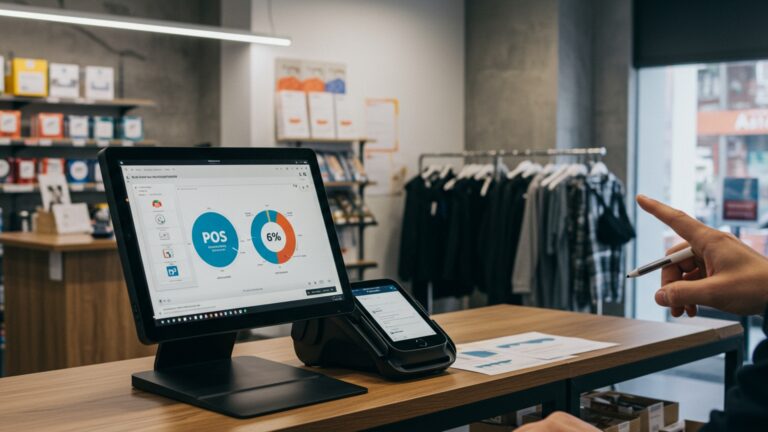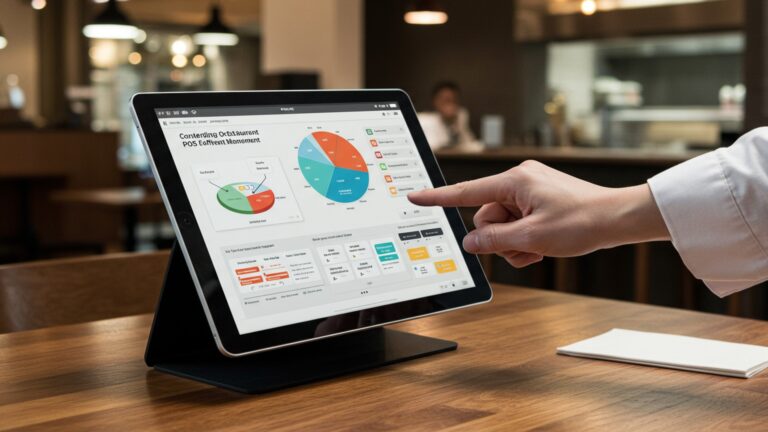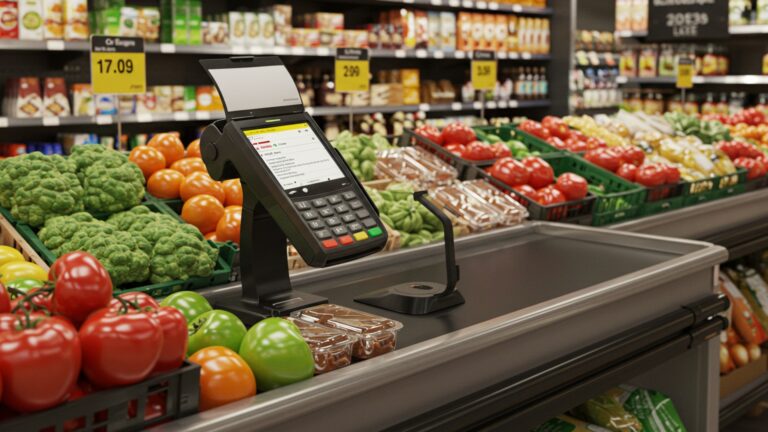How to Master Cloud POS Software for Seamless Business Operations
The contemporary business landscape demands unprecedented agility, pushing retailers and hospitality providers beyond static systems to dynamic, connected solutions. Traditional point-of-sale infrastructures often bottleneck growth, characterized by fragmented data, slow updates. a lack of real-time visibility. This era of rapid digital transformation necessitates a robust, adaptable platform. here, cloud based pos software emerges as the indispensable backbone for modern operations. It seamlessly integrates real-time inventory synchronization, comprehensive customer relationship management. dynamic sales analytics, empowering businesses to offer personalized omnichannel experiences and optimize stock levels instantly across all touchpoints. Mastering this sophisticated technology is not merely an upgrade; it is critical for achieving unparalleled operational efficiency, enhancing data security. delivering the frictionless customer journey, from mobile ordering to expedited checkout, that today’s consumers unequivocally expect.

Understanding Cloud POS Software: The Foundation of Modern Retail
In today’s fast-paced business environment, the way transactions are processed and managed has evolved dramatically. At the heart of this evolution lies the Point of Sale (POS) system. Traditionally, a POS system was a standalone terminal in a store, handling sales and perhaps basic inventory. But, the advent of cloud technology has revolutionized this, giving rise to cloud based POS software – a powerful tool that transcends the limitations of its predecessors.
A POS system, in its simplest form, is where a customer makes a payment for goods or services. It’s the point where a retail transaction is completed. When we add “cloud” to this, we’re referring to software that operates over the internet, storing data on remote servers rather than on local hardware. This fundamental shift brings a host of advantages, making it a critical component for businesses seeking seamless operations.
Here’s a breakdown of key terms:
- Point of Sale (POS)
- Cloud Computing
- Cloud POS
- SaaS (Software as a Service)
The specific location where a customer completes a transaction.
The delivery of on-demand computing services—including servers, storage, databases, networking, software, analytics. intelligence—over the Internet (“the cloud”).
A POS system where the software and data are hosted on remote servers and accessed via the internet. This means you can run your business from anywhere, on any device with an internet connection.
A software distribution model in which a third-party provider hosts applications and makes them available to customers over the Internet. Most cloud based POS software operates on a SaaS model.
The distinction between traditional, on-premise POS and modern cloud based POS is significant:
| Feature | Traditional (On-Premise) POS | Cloud Based POS Software |
|---|---|---|
| Data Storage | Local servers, often within the business premises. | Remote, secure cloud servers (accessed via internet). |
| Accessibility | Limited to the physical location where the server is installed. | Accessible from anywhere, on any internet-enabled device. |
| Cost Structure | High upfront costs for hardware, software licenses. maintenance. | Subscription-based model, lower upfront costs, predictable monthly fees. |
| Updates & Maintenance | Manual updates, often requiring IT intervention; business downtime. | Automatic, seamless updates by the provider; minimal to no downtime. |
| Scalability | Challenging and expensive to scale; requires new hardware. | Easily scalable up or down to meet business demands. |
| Security | Relies on local IT expertise; vulnerable to on-site issues. | Managed by cloud experts; robust security protocols, data backups. |
Choosing a robust cloud based POS software is no longer a luxury but a strategic necessity for businesses aiming for efficiency, flexibility. growth.
Key Features to Look for in Your Cloud Based POS Software
Selecting the right cloud based POS software is paramount to unlocking its full potential. While basic transaction processing is a given, the true power lies in its advanced features that streamline operations and provide actionable insights. When evaluating options, consider these critical functionalities:
- Intuitive Sales Processing & Payment Integration
- Ease of Use
- Flexible Payment Options
- Offline Mode
- Comprehensive Inventory Management
- Real-time Tracking
- Product Variants
- Supplier Management
- Barcode Scanning
- Robust Customer Relationship Management (CRM)
- Customer Profiles
- Loyalty Programs
- Targeted Marketing
- Powerful Reporting & Analytics
- Sales Reports
- Product Performance
- Employee Performance
- Customizable Dashboards
- Efficient Employee Management
- User Permissions
- Time Clock
- Performance Tracking
- Multi-Location Capabilities
- For businesses with multiple branches, the cloud based POS software should allow centralized management of inventory, sales. customer data across all locations from a single dashboard.
- Seamless Integrations
- E-commerce Platforms
- Accounting Software
- Third-Party Apps
The interface should be user-friendly, allowing new staff to quickly learn the system.
Support for credit/debit cards, mobile payments (Apple Pay, Google Pay), gift cards. even split payments. Integration with reputable payment processors is crucial for security and efficiency.
Essential for businesses in areas with unreliable internet. The system should be able to process sales offline and sync data once connectivity is restored.
Monitor stock levels across all locations in real-time. This prevents overselling and helps in timely reordering.
Ability to manage different sizes, colors, or other attributes of a single product.
Track supplier insights, purchase orders. receiving.
Speed up checkout and inventory counts.
Store purchase history, contact data. preferences.
Implement points-based systems, discounts, or special offers to reward repeat customers.
Use customer data to create personalized promotions and communications.
Track daily, weekly, monthly. yearly sales performance.
Identify best-selling and slow-moving items.
Monitor individual staff sales and productivity.
Visualize key metrics at a glance.
Assign different access levels to staff based on their roles.
Track employee hours for payroll accuracy.
Monitor sales by employee to identify top performers and areas for improvement.
Sync online and in-store inventory and sales (e. g. , Shopify, WooCommerce).
Connect with platforms like QuickBooks or Xero to automate financial reporting.
Compatibility with other essential business tools (e. g. , scheduling, marketing automation).
By prioritizing these features, businesses can ensure their cloud based POS software not only processes transactions but also acts as a strategic engine for growth and efficiency.
Implementing Cloud POS: A Step-by-Step Guide
Transitioning to a new cloud based POS software can seem daunting. a structured approach ensures a smooth and successful deployment. Follow these steps to master your implementation:
- Assess Your Business Needs
- Vendor Selection and Due Diligence
- Reputation and Reviews
- Feature Set
- Pricing Model
- Customer Support
- Security Measures
- Data Migration and Setup
- Exporting data from your old system (e. g. , into CSV files).
- Cleaning up old data (removing duplicates, outdated entries).
- Importing data into the new cloud based POS software.
- Setting up product categories, tax rates, employee profiles. payment methods.
- Hardware Configuration
- Tablets (e. g. , iPads, Android tablets) or traditional POS terminals.
- Barcode scanners.
- Receipt printers.
- Cash drawers.
- Payment terminals (card readers).
- Comprehensive Staff Training
- Basic transaction processing (sales, returns, exchanges).
- Inventory lookups and adjustments.
- Customer profile management.
- Opening and closing procedures.
- Troubleshooting common issues.
- Go-Live and Post-Implementation Support
- Monitor system performance closely.
- Gather feedback from staff and customers.
- Utilize the vendor’s support channels for any issues.
- Regularly review reports to ensure data accuracy and identify training gaps.
Before looking at any software, grasp your unique requirements. What are your pain points with your current system? What specific features would genuinely benefit your operations? For example, a restaurant will have different needs (table management, kitchen display system) than a retail store (inventory variants, e-commerce sync). Document these essential and desired features.
Based on your needs, research potential cloud based POS software providers. Look for:
Check industry reviews, testimonials. case studies.
Ensure it aligns with your assessed needs.
grasp all costs – subscription fees, transaction fees, hardware costs, support costs.
Evaluate their responsiveness, availability (24/7?). support channels (phone, email, chat).
Inquire about data encryption, PCI compliance. backup protocols.
Request demos and free trials. Don’t hesitate to ask specific questions about how the software handles your unique scenarios. For instance, “How does your cloud based POS software manage returns across multiple locations?”
This is a critical phase. You’ll need to transfer existing product data, customer details. potentially sales history into the new system. Most cloud POS providers offer tools or assistance for this. Ensure data accuracy and integrity during this process. This might involve:
While the software is cloud-based, you’ll still need hardware at your physical locations. This typically includes:
Ensure all hardware is compatible with your chosen cloud based POS software and is properly installed and connected to your network. Test all components thoroughly.
Your team is on the front lines, so their proficiency with the new system is vital. Conduct thorough training sessions for all staff members who will interact with the POS. Cover:
Encourage practice and provide a safe environment for questions. Consider creating quick-reference guides for common tasks.
Choose a low-traffic time for your official launch. Have key personnel and, if possible, support from your POS vendor on-site during the initial hours or days. Be prepared for minor hiccups and address them quickly. After going live:
A well-executed implementation of your cloud based POS software lays the groundwork for long-term success and seamless business operations.
Optimizing Your Cloud Based POS for Peak Performance
Implementing a cloud based POS software is just the beginning. To truly master it and drive seamless business operations, continuous optimization is key. This involves leveraging its full capabilities and adapting it to your evolving business needs.
- Leveraging Analytics for Informed Business Decisions
- Identify Sales Trends
- Optimize Pricing
- comprehend Customer Behavior
- Monitor Employee Performance
- Streamlining Inventory Workflows
- Automate Reordering
- Reduce Shrinkage
- Manage Multi-Location Stock
- Enhancing the Customer Experience
- Faster Checkouts
- Personalized Interactions
- Flexible Returns & Exchanges
- Loyalty Programs
- Securing Your Data and System
- Strong Passwords & User Permissions
- Regular Audits
- Stay Updated
- Backup Procedures
- Continuous Training and Adaptation
One of the most powerful aspects of cloud based POS software is its ability to generate rich data. Don’t just collect it – examine it! Regularly dive into your reports:
Discover peak selling times, popular products. seasonal fluctuations. This insight can inform staffing, inventory ordering. marketing campaigns. For example, a small bakery might notice that their artisanal sourdough sells best on weekends, prompting them to bake more on Fridays.
Use sales data to identify items that could benefit from price adjustments, promotions, or bundling.
review purchase history to segment customers, comprehend their preferences. tailor loyalty programs or promotions.
Track individual sales metrics to identify top performers, provide targeted training. incentivize strong performance.
Actionable Takeaway: Schedule weekly or monthly “data review” sessions with your team to discuss insights and translate them into concrete strategies.
Effective inventory management is crucial for profitability. Your cloud based POS software can be a game-changer here:
Set minimum stock levels to trigger automatic reorder alerts or even direct purchase orders to suppliers when inventory runs low.
Use features like stock takes, inventory adjustments. vendor returns to keep your inventory accurate and minimize losses.
If you have multiple stores, use the software to transfer stock efficiently between locations based on demand, reducing waste and ensuring products are where they’re needed most. A clothing boutique owner, for instance, used their cloud POS to see a specific dress was selling out in one branch but had excess stock in another, enabling a quick transfer to meet demand.
A seamless POS experience directly impacts customer satisfaction and loyalty.
Ensure staff are proficient with the system to process transactions quickly and accurately.
Use the CRM features to greet returning customers by name, recall their preferences. suggest relevant products based on past purchases.
A well-integrated cloud based POS software makes returns and exchanges smooth, even without a physical receipt if customer data is readily available.
Actively promote and manage loyalty programs through the POS to encourage repeat business.
While cloud providers handle much of the security, you still have a role to play:
Enforce strong, unique passwords for all staff and configure user roles to grant only necessary access.
Periodically review access logs and employee activity within the cloud based POS software to detect any anomalies.
Ensure your operating systems and browsers on POS devices are always up-to-date to benefit from the latest security patches.
interpret your cloud provider’s backup policies and ensure your critical data is recoverable.
Cloud based POS software is constantly evolving with new features and updates. Regular, refresher training ensures your team is always utilizing the system to its fullest. Encourage feedback from staff on how the system can be better used to improve their workflow and customer interactions.
Real-World Success: Case Studies and Best Practices
The theoretical benefits of cloud based POS software come to life when we look at how businesses are actually leveraging it for tangible results. These real-world applications highlight best practices and actionable takeaways.
- Case Study 1: “The Daily Grind” Coffee Shop – Boosting Efficiency and Customer Loyalty
- Challenge
- Solution
- Results
- Actionable Takeaway
- Case Study 2: “Fashion Forward” Boutique – Seamless Multi-Store Management
- Challenge
- Solution
- Results
- Actionable Takeaway
- Case Study 3: “Urban Spas” Wellness Center – Streamlined Service Bookings and Payments
- Challenge
- Solution
- Results
- Actionable Takeaway
A bustling coffee shop, “The Daily Grind,” struggled with long queues during peak hours due to a slow, outdated traditional POS. Managing customer loyalty manually was cumbersome. inventory tracking was a weekly, error-prone chore.
They implemented a leading cloud based POS software. The system’s intuitive interface allowed baristas to process orders rapidly on iPads. They integrated a digital loyalty program, where customers earned points automatically with each purchase, redeemable for free drinks. The cloud POS also enabled real-time inventory tracking for coffee beans, milk. pastries, alerting managers when stock levels were low.
Queue times reduced by 25%, leading to higher customer satisfaction. The loyalty program saw a 40% increase in repeat customers within six months. Automated inventory reduced waste by 15% and saved staff 5 hours per week on manual checks.
Prioritize an intuitive interface and integrated loyalty features in your cloud based POS software to enhance both operational efficiency and customer engagement, especially in high-volume environments.
“Fashion Forward,” a small chain of three independent fashion boutiques, faced significant challenges in managing inventory across locations. A dress might sell out in one store while sitting idle in another. Consolidated sales reporting was a manual, month-end nightmare.
They adopted a cloud based POS software with robust multi-location capabilities. This allowed them to centralize their entire inventory, sales data. customer data. Managers could view real-time stock levels at all three stores from a single dashboard and easily initiate inter-store transfers for in-demand items.
Inventory turnover improved by 20% as they could quickly rebalance stock. Consolidated sales reports, available instantly, helped them identify top-performing products and underperforming stores, informing better buying decisions. Customer records were accessible at any store, improving personalized service.
For businesses with multiple locations, a cloud based POS software that offers centralized inventory and reporting is indispensable for optimizing stock, sales. customer experience across all branches.
“Urban Spas” struggled with managing appointments, processing varied service payments. tracking client history effectively. Their old system was disjointed, leading to booking conflicts and lost client insights.
They implemented a specialized cloud based POS software designed for service-based businesses, which included integrated appointment scheduling, client management. payment processing. Clients could book and pay online. the system automatically updated the spa’s calendar.
Booking errors were virtually eliminated. The integrated system provided a comprehensive view of each client’s service history, allowing staff to offer personalized recommendations. Online booking and payment reduced administrative workload by 30%, freeing up staff to focus on client care.
Service-based businesses should seek cloud based POS software that offers integrated scheduling and client management alongside payment processing to streamline operations and enhance client satisfaction.
These examples underscore that the right cloud based POS software is more than just a payment terminal; it’s a strategic business tool that, when optimized, can lead to significant improvements in efficiency, profitability. customer loyalty.
Addressing Common Challenges and Future Trends
While cloud based POS software offers immense benefits, businesses should be aware of potential challenges and how to mitigate them. Moreover, understanding emerging trends can help future-proof your operations.
- Common Challenges and Solutions
- Internet Connectivity Issues
- Challenge
- Solution
- Data Security Concerns
- Challenge
- Solution
- Vendor Lock-in
- Challenge
- Solution
- Learning Curve for Staff
- Challenge
- Solution
- Future Trends in Cloud POS Software
- AI and Machine Learning Integration
- Enhanced Mobile POS (mPOS) Solutions
- Omnichannel Retail Experience
- Contactless Payments and Biometrics
- Voice Commerce Integration
As cloud-based systems rely on the internet, connectivity disruptions can halt operations.
Choose a cloud based POS software that offers a robust “offline mode.” This allows you to continue processing sales even without internet, with data syncing automatically once connection is restored. Also, consider having a reliable backup internet source (e. g. , a mobile hotspot or a secondary ISP).
Storing sensitive business and customer data on remote servers raises questions about security and privacy.
Select a reputable cloud based POS software vendor that demonstrates strong security protocols, including data encryption, PCI compliance, regular security audits. robust backup and disaster recovery plans. interpret their data privacy policies and ensure they align with regulations like GDPR or CCPA. Implement strong internal security practices, such as unique, complex passwords and multi-factor authentication for all users.
Becoming too dependent on a single vendor can make it difficult to switch providers or integrate with other systems later on.
Before committing, inquire about data portability – how easy is it to export your data if you decide to switch? Look for cloud based POS software that offers open APIs (Application Programming Interfaces) for easier integration with other business tools you might use (e. g. , accounting, CRM, e-commerce). This flexibility ensures your system can evolve with your business without being tied down.
Adopting a new system can be met with resistance or difficulty by staff.
Invest in comprehensive and ongoing training. Choose a cloud based POS software known for its intuitive user interface. Provide easy-to-access support resources (e. g. , quick guides, video tutorials). Involve staff in the selection process to foster buy-in and address their concerns early.
The landscape of cloud based POS software is constantly innovating. Staying abreast of these trends can give businesses a competitive edge:
Expect more advanced analytics, predictive inventory management (forecasting demand based on historical data and external factors). personalized customer recommendations driven by AI. Imagine your POS suggesting optimal staffing levels for the next week based on projected sales.
The shift towards mobile devices (tablets, smartphones) as POS terminals will continue, offering greater flexibility for pop-up shops, field sales, or even tableside ordering in restaurants. This empowers staff to serve customers anywhere in the store.
Cloud based POS software will increasingly serve as the central hub for a truly seamless omnichannel experience, blurring the lines between online and physical retail. This means unified inventory, customer data. promotions across all touchpoints – web, mobile. brick-and-mortar.
The demand for secure, fast. hygienic payment methods will drive further adoption of contactless card payments, mobile wallets. potentially biometric authentication (e. g. , fingerprint, facial recognition) at the POS.
As voice assistants become more prevalent, future POS systems might integrate voice commands for tasks like inventory checks or even processing sales, offering another layer of efficiency.
Conclusion
Mastering Cloud POS software isn’t merely about digitizing transactions; it’s about embedding a dynamic intelligence into your daily operations, transforming it into your business’s seamless operational backbone. By proactively engaging with its real-time inventory reconciliation, detailed sales analytics. seamless contactless payment integration, you move beyond basic functionality. My personal tip is to designate a ‘POS champion’ within your team who actively explores new features and conducts brief, regular training sessions; I’ve seen firsthand how this fosters adoption and unlocks incredible efficiencies, especially in today’s fast-evolving retail landscape. Leverage the power of data-driven insights to predict trends, optimize staffing. enhance customer experiences, adapting to today’s dynamic market needs with agility. This commitment to understanding and utilizing your Cloud POS isn’t just about streamlining; it’s about building a resilient, future-proof business poised for scalable growth. Embrace this technology not as a cost. as a strategic partner that empowers your team, delights your customers. propels you ahead of the competition.
More Articles
How to Leverage Cloud Based POS Software for Scalable Business Growth
Guide to Implementing Mobile POS Software for Flexible Business Transactions
Learn How POS Software Can Revolutionize Your Small Business Operations
Master Billing and POS Software Integration for Enhanced Business Efficiency
How to Choose the Best POS Software for Your Retail Store Success
FAQs
What exactly is Cloud POS and why is it such a big deal for businesses these days?
Cloud POS (Point of Sale) software runs over the internet, not on a physical server in your shop. It’s a big deal because it lets you manage sales, inventory, customers. reporting from anywhere, anytime, using any device with an internet connection. It brings flexibility, real-time data. often lower upfront costs compared to traditional systems.
Okay, I’m new to this. Where do I even begin to learn how to use Cloud POS effectively?
Start with the basics! Most Cloud POS providers offer excellent onboarding guides, video tutorials. knowledge bases. Don’t try to learn everything at once. Focus on core functions like processing sales, adding products. checking out customers first. Practice in a demo or training mode if available. don’t hesitate to ask your provider for initial setup support.
What are the absolute must-master features in Cloud POS to really make my operations seamless?
To truly master it, focus on inventory management (tracking stock, reorders), customer relationship management (building profiles, loyalty programs), sales reporting and analytics (understanding trends, peak times). employee management (permissions, time tracking). These features, when utilized fully, are game-changers for efficiency and decision-making.
My team is a bit resistant to change. How can I ensure everyone actually uses the new Cloud POS properly?
Training is key! Don’t just show them once. Provide hands-on training sessions, create simple cheat sheets for common tasks. highlight how the new system will make their jobs easier, not just yours. Designate a “super user” or two who can help others. encourage questions. Patience and positive reinforcement go a long way.
What if I run into a problem or need technical help? Is support usually good with these cloud systems?
Good Cloud POS providers typically offer robust support channels. Look for options like 24/7 chat, email, phone support. comprehensive online help centers. Before you pick a system, check their support reputation. Knowing you have reliable help available is crucial for keeping your operations smooth.
How does using Cloud POS actually make my day-to-day business operations run smoother?
It streamlines so much! Real-time inventory updates prevent stockouts and overselling. Faster checkout times improve customer experience. Automated reporting saves hours on manual data entry. Plus, being able to access everything from anywhere means you’re always in control, whether you’re on the shop floor or managing from home.
Can I really access my business data and manage sales from anywhere with Cloud POS?
Absolutely! That’s one of its biggest perks. As long as you have an internet connection, you can log in from a tablet, smartphone, or laptop, whether you’re at home, on vacation, or at a different business location. This mobility gives you incredible flexibility to monitor sales, adjust inventory. even process transactions on the go.






